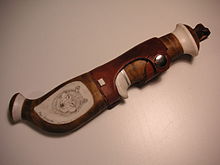- Duodji
-
Duodji is a centuries old Sami handicraft, that dates back to a time when the Sami were far more isolated from the outside world than they are today. Duodji tools and clothing accoutrements served their purpose to be functional and useful, however this does not mean that the Sami handicraft is unartistic. Sami doudji artists are able to bring function and art together in such a delicate way to create beautiful works of art in their own right.
These functional items include, knives, cases, ladies bags, wooden cups, certain articles of clothing, etc. Duodji items were made and meant to be used in an everyday work environment.
Contents
Materials used
Traditionally Sami handicraft was divided into two sub-groups, men’s and women's handicraft. Men used mostly wood and antlers as well as other bones from reindeer when crafting, while women used leather and roots. The traditional Sami colours are red, green, blue and yellow.
Well known Sami Duodji artists
Duodji artists are still active in Sapmi and still carrying on the traditions of the Doudji. Although there have been slight changes in the traditional Duodji, today they are considered valuable pieces of art by collectors from all over the world. Some of the Duodji artists today are Olov Svonni, Martin Kuorak, Anders Sunna, Lars Pirak and Per Olof Utsi.
Gakti
The traditional costume, the gákti, is of great cultural importance and is mainly used for weddings, funerals, confirmations and other cultural events. The gákti’s appearance differs from place to place and it tends to be longer in southern Sápmi than in the north. Traditionally leather, sinews, and wool was used to make the gákti, today however both velvet and silk can be used.
Duodji gallery
See also
External links
- Duodji at Design-Handverk [1]
- Doudji Institute: http://www.duodji.info/english/index.php?sladja=46 Retrieved Jan/29/2008
- Sameslöjdstiftelsen (Sami Duodji Association): http://www.sameslojdstiftelsen.com/?p=42 Retrieved Jan/29/2008
Categories:- Sami
- Arts and crafts
- Sami language terms
Wikimedia Foundation. 2010.










